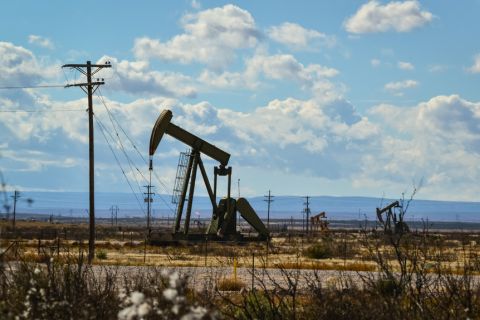
Energy producers have adjusted their strategies with ambitions to hit net-zero emissions goals. (Source: ATK Work/Shutterstock.com)
The transition to cleaner forms of energy is likely to take decades, not years, but 2022 could bring progress toward goals established by companies aiming to further reduce emissions, find and produce lower-carbon barrels and advance certain technologies.
Key to hitting net-zero goals by 2050 are adopting technologies such as carbon capture, utilization and storage (CCUS), advancing battery technology and storage, increasing use of renewable energy sources and expanding the production of zero- or low-carbon hydrogen to cut global emissions.
Many of the world’s energy producers have already adjusted their strategies by pledging, for example, to end routine flaring, stepping up direct emissions reduction efforts and undertaking other energy efficiency and power projects. Some traditional oil and gas players are also teaming up with others in the energy sector on carbon capture and storage (CCS) projects or partnering with smaller startups looking to scale their proven technologies.
Marius Kluge Foss, senior vice president and head of Global Energy Systems for Rystad Energy, shared insight with Hart Energy on what 2022 could hold for the energy transition.
Hart Energy: What type of energy transition decarbonization investments could the industry see more of in 2022?
Foss: In terms of investments we expect the continued buildup of green technology to facilitate the energy transition. This includes ongoing construction of battery factories, expansion of battery raw material mines, energy storage systems (ESS), electrolyzer and solar PV manufacturing capacity, as well as the existing pipeline of CCS and hydrogen projects. Beyond investments we expect 2022 to be a year of increased commitment to a lot of the plans set out in 2020/21. We’ve seen a wave of project announcements, especially within CCS and hydrogen, and we hope that these projects will mature into 2022 and ideally move to FID to de-risk these projects.
Hart Energy: Some U.S. E&Ps reported record cash flows in 2021. What are the chances that some of that money will go toward projects aimed at reducing emissions and carbon management?
Foss: Some of this money will definitely flow into emission reduction and carbon management, but in general we expect the E&P companies to stick to their communicated decarbonization strategies and that the record cash flows seen in 2021 not necessarily increase the share of spending on green technologies. That said, the improved cash flow could accelerate some of these projects. Another point, although not directly linked to cash flow, is the Global Methane Pledge that was signed by more than 104 countries during COP26. The pledge of cutting global methane emissions by 30% by 2030 should generate some initial investments in the U.S. gas sector, which would include reduction of methane leakages from upstream and midstream.
Hart Energy: Much appears to be riding on CCUS during this transition to a lower-carbon world; however, some projects in the U.S. have faced technical and financial challenges. What do you think is critical for the industry to have successful CCUS projects both onshore and offshore?
Foss: The financial challenges for CCUS is likely the major hurdle. CCUS is still more expensive than the carbon credits received through the 45Q facilitate for, for most of the applications. An increase in the tax credits should improve this, but there’s also an inherent project risk involved in investing in CCUS infrastructure when there are other abatement options that are becoming increasingly competitive. Examples include replacing fossil-based power generation with solar and/or wind coupled with energy storage, or decarbonization of industry through electrification, or hydrogen for high heat requirements.
Hart Energy: What are some of the key themes for hydrogen in 2022?
Foss: Scaleup of electrolyzer manufacturing and economies of scale to bring down green LCOH (levelized cost of green hydrogen); commitment to blue hydrogen projects; increased interest in pink (nuclear) and turquoise (methane pyrolysis) hydrogen and increased focus on hydrogen derived energy carriers such as ammonia and synthetic fuels.
Hart Energy: Is there any low-hanging fruit that oil and gas companies can easily reach to further reduce emissions and better manage carbon in 2022?
Foss: Methane emission cuts and reduced flaring are some of the lowest hanging fruits in the industry, and the areas that differentiates the emission intensity of the various regions the most. Both are relatively easy to address and can have economic benefits as more of the gas can be sold rather than lost.
Recommended Reading
Range Resources Holds Production Steady in 1Q 2024
2024-04-24 - NGLs are providing a boost for Range Resources as the company waits for natural gas demand to rebound.
EQT Sees Clear Path to $5B in Potential Divestments
2024-04-24 - EQT Corp. executives said that an April deal with Equinor has been a catalyst for talks with potential buyers.
Novo II Reloads, Aims for Delaware Deals After $1.5B Exit Last Year
2024-04-24 - After Novo I sold its Delaware Basin position for $1.5 billion last year, Novo Oil & Gas II is reloading with EnCap backing and aiming for more Delaware deals.
Matador Hoards Dry Powder for Potential M&A, Adds Delaware Acreage
2024-04-24 - Delaware-focused E&P Matador Resources is growing oil production, expanding midstream capacity, keeping debt low and hunting for M&A opportunities.
TotalEnergies, Vanguard Renewables Form RNG JV in US
2024-04-24 - Total Energies and Vanguard Renewable’s equally owned joint venture initially aims to advance 10 RNG projects into construction during the next 12 months.






